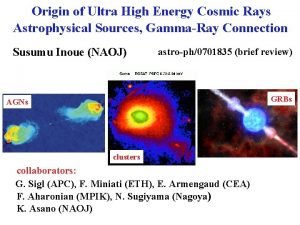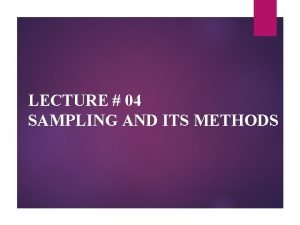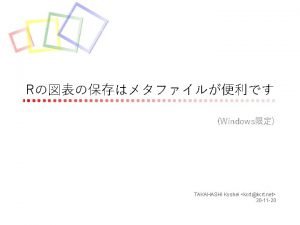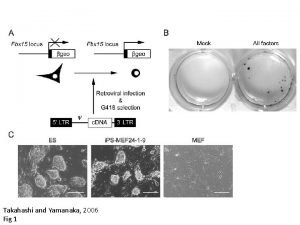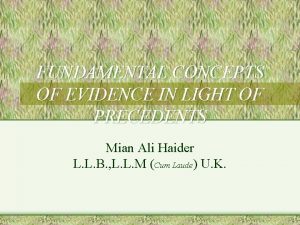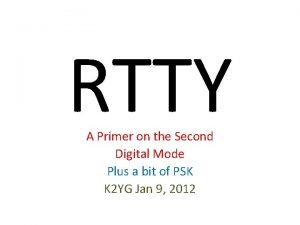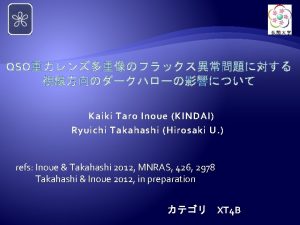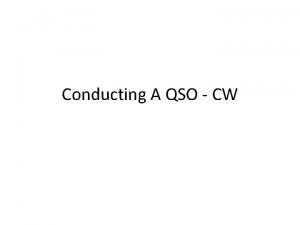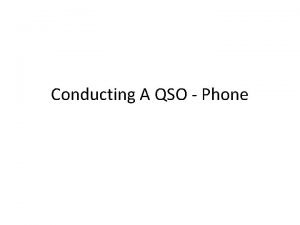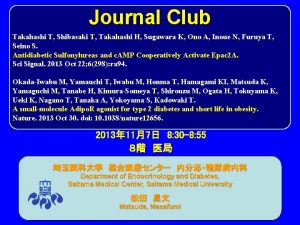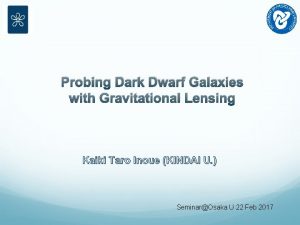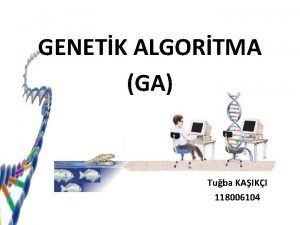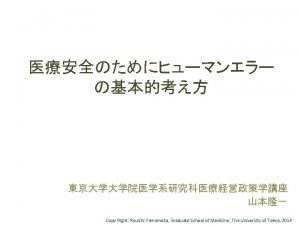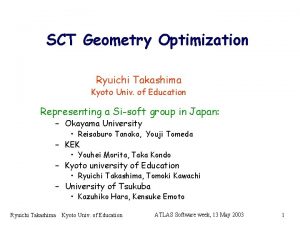QSO Kaiki Taro Inoue KINDAI Ryuichi Takahashi Hirosaki





























![MIR QSO-galaxy quads Ø 6 samples: 5 continuum 1 line [OIII] Ø SIE-ES model MIR QSO-galaxy quads Ø 6 samples: 5 continuum 1 line [OIII] Ø SIE-ES model](https://slidetodoc.com/presentation_image_h/1596e1647b6904b4c061a68559662fd8/image-30.jpg)










































- Slides: 72

QSO重力レンズ多重像のフラックス異常問題に対する 視線方向のダークハローの影響について Kaiki Taro Inoue (KINDAI) Ryuichi Takahashi (Hirosaki U. ) refs: Inoue & Takahashi 2012, MNRAS, 426, 2978 Takahashi & Inoue 2012, in preparation カテゴリ XT 4 B


Flux- ratio anomalies Sub halos QSO galaxy

Flux- ratio anomalies Ø Sub halos but predicted subhalos too low for anomalies (Maccio & Mirranda 2006, Amara et al. 2006; Xu et al. 2009, 2010; Chen 2009; Chen et al. 2011) Ø Luminous satellites may contribute significantly (Mc. Kean et al. 2007, Shin & Evans 2008; Mac. Leod et al. 2009) Ø Line-of-sight halos? (Chen et al. 2003, Metcalf 2005, Xu et al. 2011)

Flux- ratio anomalies Sub halos QSO galaxy

QSO galaxy Satellites Group galaxy

Flux- ratio anomalies Ø Sub halos but predicted subhalos too low for anomalies (Maccio & Mirranda 2006, Amara et al. 2006; Xu et al. 2009, 2010; Chen 2009; Chen et al. 2011) Ø Luminous satellites may contribute significantly (Mc. Kean et al. 2007, Shin & Evans 2008; Mac. Leod et al. 2009) Ø Line-of-sight halos? (Chen et al. 2003, Metcalf 2005, Xu et al. 2011)

Flux- ratio anomalies Ø Sub halos but predicted subhalos too low for anomalies (Maccio & Mirranda 2006, Amara et al. 2006; Xu et al. 2009, 2010; Chen 2009; Chen et al. 2011) Ø Luminous satellites may contribute significantly (Mc. Kean et al. 2007, Shin & Evans 2008; Mac. Leod et al. 2009) Ø Line-of-sight halos? (Chen et al. 2003, Metcalf 2005, Xu et al. 2011)

Flux- ratio anomalies QSO galaxy Sub halos

Line-of-sight halos QSO galaxy Sub halos

先行研究 1 Metcalf 2005 Line-of-sight halos は flux anomaly を説明可能 Ray-tracing simulation Line of sight halos ・Sheth-Tormen (2002) mass function でランダム分布 ・ NFW halo model with M<10^10 Msun 像の位置のずれの影響も議論

先行研究 2 Xu+ 2012 Line-of-sight halos は sub halos と同程度に効く Ray-tracing simulation Line of sight halos ・Millennium simulation II (Boylan-Kolchin+ 2009) の halo catalogue ・Sheth-Tormen (2002) mass function でランダム分布 NFW, SIS halo model with M>10^6 Msun の場合ののみ

6 MIR quadruple lenses

Our work Ø Semi-analyitic estimate based on VERY high resolution N-body simulation fully incorporating clustering effects of M>10^5 solar mass halos Ø Astrometric shifts taken into account Ø New static rather than ‘classic’ cusp-caustic relations Ø Only MIR lenses. Source sizes =O[1 pc]

Magnification perturbation singular isothermal elliposoid(SIE)+ external shear model で 像の位置を再現 MG 0414+0534


New statistic η magnification contrast η : effective magnification perturbation A, C: minimum B: saddle 観測値 obs

B 1422+231 A minimum B saddle minimum C

New statistic η convergence two-point correlation function k: background convergence g: background shear

Constrained 2 -point correlation Dark matter の揺らぎの power spectrum

Constrained 2 -point correlation 普通の2点角度相関 unperturbed path 今回の2点角度相関

MG 0414+0534


Astrometric shifts Intervening halo lensing により像の相対位置をずらしてはいけない Given by accuracy in position of centroid ε Minimum wavenumber given by ε

Non-linear power spectrum

N-body Simulation Ø Two 512^3 one 1024^3 colissionless particles simulations : baryons are not included. Ø Box-size=10 Mpc/h code: L-Gadget 2 (Springel et al. ) Ø Plus simulations with box-size=320, 800, 2000 Mpc/h Ø HITACHI SR 16000 512 CPUs, CPU time >3 months Ø Concordant LCDM (WMAP 7 yr+H_0+BAO)

Non-linear power spectrum Halo – fit by our work Halo – fit by Smith et al. 2003

Non-linear power spectrum Halo – fit by our work Halo – fit by Smith et al. 2003

Application to MIR lenses
![MIR QSOgalaxy quads Ø 6 samples 5 continuum 1 line OIII Ø SIEES model MIR QSO-galaxy quads Ø 6 samples: 5 continuum 1 line [OIII] Ø SIE-ES model](https://slidetodoc.com/presentation_image_h/1596e1647b6904b4c061a68559662fd8/image-30.jpg)
MIR QSO-galaxy quads Ø 6 samples: 5 continuum 1 line [OIII] Ø SIE-ES model possibly with SIS for a luminous satellite (gravlens by Keeton) Ø Astrometric shifts given by position errors (CASTLES) in lensed images and lens & size of critical curves -> minimum wavelength.

MIR quadruple lenses

Result I observation source redshift

Summary Ø Clustering line-of-sight halos with M=10^3 -7 solar mass can explain the observed anomalous flux ratios without any substructures inside a lensing galaxy. Ø The estimated amplitudes of convergence perturbation increase with the source redshift as predicted by theoretical models. Ø Unique probe into mini-halos M<10^6 solar mass



Fitting function of non-linear matter power spectrum Halo-fit model our model ~ 30% discrepancy <10% agreement ● ● :simulation results 36

w=-0. 8 w=-1. 2

Fitting function of non-linear matter power spectrum Halo-fit model our model ~ 30% discrepancy <10% agreement Cosmic shear, convergence power spectrum & correlation function

Fitting function of non-linear matter power spectrum Halo-fit model our model ~ 30% discrepancy <10% agreement Cosmic shear, convergence power spectrum & correlation function 10% up

Fitting function of non-linear matter power spectrum Halo-fit model our model ~ 30% discrepancy <10% agreement Cosmic shear, convergence power spectrum & correlation function RT, Sato, Nishimichi, Taruya, Oguri, 2012, Ap. J in press 計算コードは CAMB に標準搭載 10% up






Future work Ø Consistency check using light-ray tracing simulations (N(>2)-point correlation effects, etc. ) Ø Minimum change in astrometric shift for lensed image & lens. Ø Check of SIE+ES, luminous group/satellite galaxies Ø Extention to radio lenses incorporating finite sourcesize effects


Outline Ø Ø Ø Introduction (flux ratio anomalies) Magnification perturbation Non-linear power spectrum Application to MIR lenses Summary Future work

Introduction

Suppression Mechanism Ø Baryon physics (reionization, tidal disruption due to disk, SNe feedback) Ø New physics (warm dark matter, self-interacting DMs, super WIMPs, non-trivial inflaton dynamics ) Ø Need to probe clustering property of halos with M<10^9 solar mass

11. 2 Mpc Simulation by Sawara et al. 2012

Sub halos QSO ETG

Missing Satellite Problem M<10^9 solar mass

Parity of lensed images

Systematic (de)magnification (Δκ>0)

QSO galaxy

MG 0414+0534

MG 0414+0534 minimum saddle

MG 0414+0534 2ε

MG 0414+0534

MIR quadruple lenses

Result II

MG 0414+0534

MG 0414+0534 minimum saddle

Astrometric shifts

Astrometric shifts 2 -point correlation in shift of image separated by θ Given by power spectrum P(k)

Astrometric shifts Minimum wavenumber given by the size of Einstein radius

Astrometric shifts

Astrometric shifts Super cluster galaxy External shear SIE, SIS satellite Mini-halo Pertur -bation

Constrained convergence power ØAccuracy in position of lensed images & lens ØSize of Einstein ring

Constrained r. m. s. convergence

MIR quadruple lenses Ø Source size estimated from dust reverberation method ~ 1~3 pc >>Einstein radius of stars (by Chiba et al 2005 & Minezaki et al. 2009)
 Inoue
Inoue Ninoue
Ninoue Rumus wibisono populasi tidak diketahui
Rumus wibisono populasi tidak diketahui Simple random sample formula
Simple random sample formula Capa
Capa Ambrosio i nettaro
Ambrosio i nettaro Doraemon urashima taro
Doraemon urashima taro Taro suzuki
Taro suzuki Aileen takahashi md torrance ca
Aileen takahashi md torrance ca Takahashi kyohei
Takahashi kyohei Trearty bartley
Trearty bartley Takahashi and yamanaka 2006
Takahashi and yamanaka 2006 Hayao miyazaki and walt disney
Hayao miyazaki and walt disney Kajala v noble
Kajala v noble Rtty qso example
Rtty qso example California qso party
California qso party Georgia qso party
Georgia qso party Indiana qso party
Indiana qso party
